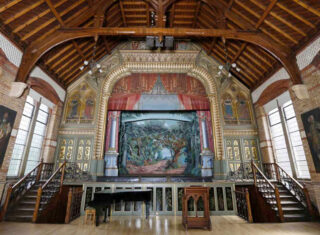Fine Art Paper Prints from the Isle of Arran, Scotland.
This is a small collection of printed images from the Isle of Arran, in a historical context. Arran is a wonderfully varied and atmospheric island. The fine art paper prints could be used for display, or kept as a photographic record.
There are nine images. The first two are printed on A3 paper and the rest on A4 paper. The Cotton Etching fine art paper is 100% cotton and acid free. It has a textured surface to accentuate detail and depth. The images are printed using pigment inks for longevity. They are presented in an acid free A3 box (archival quality).
Image 1 (A3) The Machrie Moor Standing Stones.
The print shows one of the six stone circles on Machrie Moor (Circle 2).
The image gives a sense of the atmosphere and isolation of the stone circles on the moor. The stones stand between 3.7 metres and 4.9 metres high. Some of the stones are positioned over previous timber circles and have a radiocarbon date of 2030 ± 180 BC. (Grid ref: NR911324)
Image 2 (A3) Mountain View from GoatFell.
The mountain of Goatfell stands 874m high. So, at 2866ft it is not counted as a Munro.
This photograph was taken near to the peak facing northwards, towards Lochranza. The rock formations are very impressive and spectacularly imposing, so the image is presented in monochrome, to emphasise the geology, texture and structure of the rocks. (Grid ref: NR991415)
Image 3 (A4) Machrie Stones at Dusk.
Returning to the Machrie Stone Circle at sunset was amazingly spectacular. Watching the Sun slowly move below the horizon between the stones and the Moor enter twilight was very memorable. The saturated colours affected both sky and landscape. It doesn’t take too much imagination to appreciate why ancient people from the Neolithic, Stone Age and Bronze Age used the Moor.
Image 4 (A4) King’s Cave (also known as Fionn’s cave - a mythical Irish hero)
The cave at Drumadoon (near Blackwaterfoot) was called the King’s Cave after King Robert The Bruce. He probably hid in this cave after losing a battle. During his time in the cave he had an encounter with a spider building a web. However, other places with caves also claim to be the hiding place. There are a number of carvings/drawings showing human figures, snakes and inscriptions. (Grid Ref: NR 884 309)
Ref: Further detailed information can be found on websites such as: canmore.org.uk
Image 5 (A4) Central Pillar and carvings - King’s Cave
The central pillar in the King’s Cave shows a large cross, with many other carvings from different ages. The cave has been used for religious church meetings in the past.
Image 6 (A4) Serpents and Ogham insciptions- King’s Cave
Plenty of detail in this textured image showing the carvings in the sandstone rock. The print clearly shows the carved drawings of serpents, which are situated a number of metres in from the entrance to the main cave.
There are Ogham inscriptions to the left of the serpents. (Ogham inscriptions are a medieval type of alphabet or cypher, also known as the Celtic Tree Alphabet).
Image 7 (A4) Shields?- stone carvings in the King’s Cave.
The caves have a large number of drawings/carvings.
Are they shields, masks or animal faces? No one knows.
Image 8 (A4) Hutton’s Unconformity.
James Hutton was an eighteenth-century Scottish geologist who visited Lochranza in 1787. At that time, it was thought that the Earth was about 6000 years old. Hutton’s observations on the Isle of Arran (and other places) were crucial in forming a modern understanding of geology and the age of the Earth.
This area is one of the locations he considered.
Image 9 (A4) Giant Millipede Tracks.
Along the northern coastal path from Lochranza (near Laggan) the giant millipede tracks are easily visible in the limestone rock on the shoreline, when they are above sea level. (Around 300 million years old).
In the photograph, the tracks can be seen towards the bottom of the image. The sea is just a metre below this point. You may also notice the straight-line cuts, where someone has tried (and failed) to remove the tracks from the surrounding rock.
The giant millipede was about 2metre long and 30 centimetre wide.
Realised Price: £
{CUST_LABEL_ARTIST_NAME}:
{CUST_FIELD_ARTIST_NAME}
{CUST_LABEL_SCULPTURE_DESCRIPTION}:
{CUST_FIELD_SCULPTURE_DESCRIPTION}
{CUST_LABEL_ARTIST_INTRODUCTION}:
{CUST_FIELD_ARTIST_INTRODUCTION}




